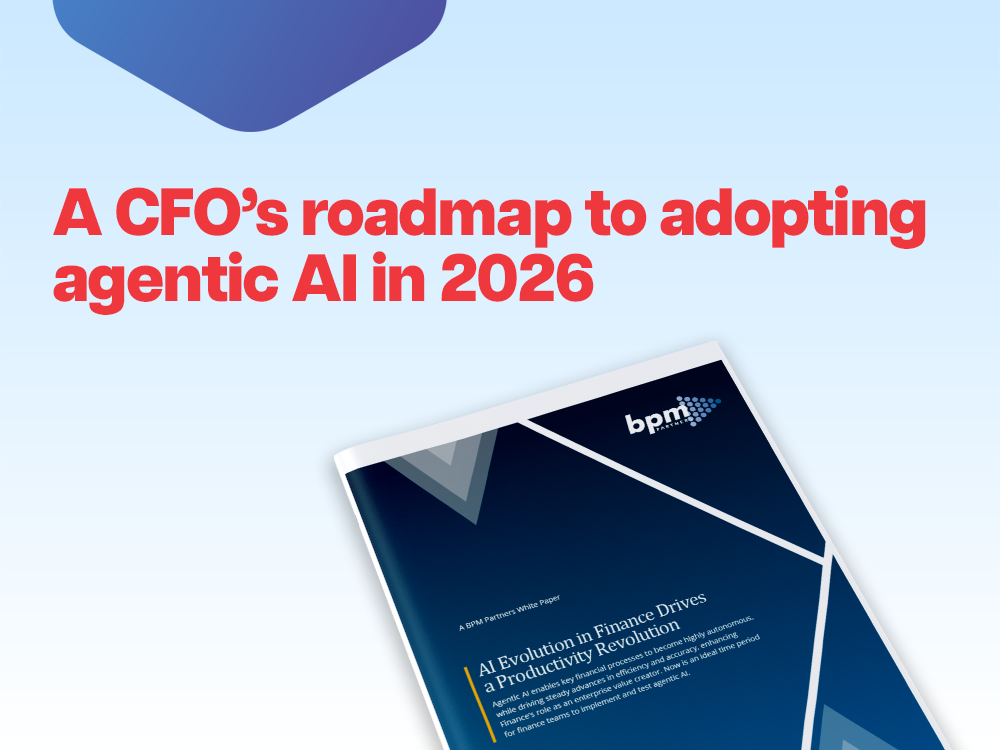Download het BPM Partners-whitepaper
AI for Financial Analysis: Use Cases, Examples & Benefits
augustus 19, 2025AI is rapidly reshaping workflows across industries, especially for finance processes. Finance teams are expected to produce accurate, timely reports, based on ever-increasing amounts of data, so leaders and other teams can make more strategic decisions.
AI tools are already making an impact, improving forecasting precision, reducing the time spent on month-end close cycles, and helping finance teams identify risks with enough time to act.
In the 2025 State of AI in Financial Services report, Nvidia surveyed 600 financial services professionals about their use of AI and the benefits they’ve seen. 68% of them saw an increase in revenue of at least 5% (with 23% seeing increases of more than 20%) while 64% saw decreases in annual costs of at least 5%.
80% of banks are using AI globally to improve operations, seeing benefits in faster fraud detection, cost savings, and more.
But you don’t have to be a bank to start seeing benefits from using AI in financial analysis. Here’s how these tools are rapidly becoming essential.
Understanding AI in financial analysis
Using AI in financial analysis goes beyond prompting ChatGPT to help with financial reports. Finance teams use a variety of dedicated AI tools in analysis, including:
- Machine learning: AI models that can learn independently from data without specific instructions. An AI model trained for fraud detection is an example of machine learning in financial analysis.
- Natural language processing: AI tools that are taught to understand human language, whether written or spoken, as well as replicate it. An AI tool that automatically scans agreements for language indicating high risk is an example of natural language processing in action.
- Predictive modeling: These AI tools use your financial data to create models and scenarios you can base further analysis on. Financial performance platforms like Prophix One use AI for predictive modeling when building revenue, expense, and other scenarios.
- Generative AI: These tools draw from a massive store of training data to create new content, like text, images, and video. Finance professionals might use generative AI to automatically fill certain sections of written reports, for example.
- Conversational AI: While conversational AI tools like ChatGPT aren’t dedicated finance tools, they still help finance professionals. You might ask ChatGPT to analyze the sentiment of an email from a coworker or brainstorm ideas ahead of writing a report, for example.
- Agentic AI: Agentic systems can act autonomously, making decisions and taking actions to achieve specific goals with minimal human intervention. Finance teams might use agentic AI to automate workflows so that transactions are monitored, anomalies identified, and audit-ready documentation is prepared – all without a prompt.
- Large language models: The technology behind AI tools like conversational AI and generative AI, large language models are fed massive quantities of data to gain the ability to answer a wide variety of prompts with their best possible guess of the correct answer.
AI tools don’t replace finance teams, only enhance their work. The more expertise your finance teams have, the more they’ll get out of these tools. By accelerating the more labor-intensive tasks involved in your finance processes, your teams can reserve their bandwidth for tasks that benefit from their time and attention. Tasks like manually preparing data for transfer between tools take a significant amount of time and assigning them to human team members brings no benefits over trusting them to AI tools.
Similarly, the volume of financial data your teams deal with artificially limits their forecasting capabilities and makes accurate reporting on trends unnecessarily difficult. Deploying the right AI tool can accelerate data processing flows, allow teams to forecast farther, and uncover more patterns through analysis.
AI applications in financial analysis with examples
AI tools allow professionals to save time and effort on essential workflows across industries. But in financial analysis, these tools allow you to address some of the most challenging issues in this essential process, from workflow inefficiencies to accurately forecasting trends in volatile markets. Additionally, AI can drastically accelerate data collection, cleaning, and loading into the platforms you need for reporting and analysis.
Here’s how.
Predictive analytics for better forecasting
Predictive analytics is essential for financial analysis. It allows financial professionals to turn existing data into forecasts and models to plan for the future. A forecast might be used as the basis to justify a planned expansion or a rebalancing of an organization’s assets, for example.
The challenge with forecasting? Pulling data from multiple sources, analyzing it, and identifying the patterns that lead to building better forecasts and more accurate scenarios.
AI tools allow you to do more with that data with less manual work. CFOs and other finance professionals can run more models, adjust their assumptions in real time, and proactively prepare for market shifts. This doesn’t just allow forecasts to be created in less time, they can also be automatically adjusted based on new data and updated assumptions with AI.
Automated workflow and financial tasks
Financial analysis involves a massive amount of manual work. Collecting data, processing it, and loading it into the right tools encapsulates much of that work. But there’s also a ton of time lost to the actual analysis of that data, with finance teams preparing, testing, and modifying hypotheses before building scenarios.
Not all tasks involved in these processes need a human touch. Some can accurately and quickly be handled by AI tools, which frees up your finance team to focus on other work, work where their attention actually adds value to your process instead of just taking up their time. Examples of AI-powered automation in finance include:
- Transaction matching
- Financial close
- Budgeting
- Forecasting
- Approvals
Prophix’s own AI engine, Prophix One Intelligence, allows financial teams to surface instant insights, naturally explain data visualizations in simplified language, auto-generate commentary, and identify key drivers behind variance.
Advanced analytics and reporting
Basic financial analysis is already challenging and labor-intensive. Once your organization’s financial picture becomes more complex—or your analysis needs become heavier—that workload can increase exponentially. As reporting needs grow, the amount of data to be analyzed increases, and your teams rapidly get swamped with additional work.
AI tools don’t just streamline financial analysis, they can also make advanced analytics more accessible for all teams. CFOs and finance leads can automatically generate ad hoc reports to cover immediate reporting needs, build dashboards and visualizations with natural language, and generate automated narratives without technical skills.
All this leads to faster decision-making across the organization, better communication with stakeholders, and deeper knowledge for all teams. An AI tool like Prophix Copilot makes self-service reporting available to all teams through natural language queries, meaning everyone can pull reports and update data just by asking a question—the same way they would with a human colleague.
Key benefits of AI insights and tools for finance teams
Two of the primary benefits of AI tools in financial analysis are an increase in revenue and a decrease in operational costs, as per Nvidia’s research. Because AI tools streamline and optimize financial analysis, every stakeholder can make better decisions. Collectively, all these decisions amount to better management of expenses and greater returns on investment, leading to a stronger bottom line for the organization as a whole.
That said, AI also brings massive benefits within the financial analysis process, including:
More accurate forecasts: Preparing a forecast depends on collecting and analyzing massive amounts of data, and it’s all too easy to miss a trend that completely transforms your forecast. AI tools can analyze the same data set several times over, making it less likely they’ll miss these subtle trends.
Shorter close cycles: The financial close is both essential to financial analysis and painstaking. Any improvements to the time and manual work involved in this process makes overall financial analysis more effective, and AI achieves both of these in spades.
Enhanced strategic planning: AI tools democratize access to financial analysis, models, and scenarios. When business leaders across the organization can get detailed, thorough reports just by asking a chatbot, it’s easier for everyone to make decisions in line with the organization’s overall strategy.
Stronger risk posture: Every organization needs to take financial risks to grow. Deeper financial analysis, powered by AI, can give you a greater understanding of each potential risk and how it fits into your broader strategy.
Challenges and best practices in implementing AI
While AI tools come with massive benefits, they can be just as difficult to implement in your organization as other software tools—and often come with additional risks. But by being aware of these challenges—and best practices that can help mitigate them—you can streamline your implementation and get more out of these tools.
The challenges of implementing AI
Before you implement a new AI tool, you should be aware of the following challenges:
- Data readiness: In most organizations, financial data is scattered across multiple platforms in different formats and with varying degrees of completeness. When that data is siloed in different tools, an AI model may not be able to make the most of it.
- Stakeholder buy-in: While most stakeholders are inclined to approve a solution that can save the organization money while improving productivity, AI tools can be a harder sell. They’re technical, and not all of them deliver on what they promise.
- Unclear ROI expectations: Some finance leaders expect AI tools to so radically transform their financial analysis processes that no tool can actually live up to their expectations.
- Training needs: Not all AI tools are as simple to use as ChatGPT. Some require training for finance teams to make the most of them.
AI implementation best practices
Despite the challenges involved, implementing AI tools brings a massive ROI that’s hard to ignore. Here are some best practices for tackling common implementation challenges:
- Adopt data hygiene practices before implementation: Your organization can only benefit from freeing data from silos and standardizing the way it’s processed. Implement these practices before you start using AI tools.
- Begin with small pilot projects: Getting stakeholder buy-in to implement AI tools across your entire organization might create resistance, but few stakeholders will say no to testing a tool through a smaller project first.
- Clearly map out ROI: Calculate the amount of time, money, and effort needed for your financial analysis process. Estimate the cost savings AI brings. Then, estimate the value that broadly available financial analysis would bring to the organization. Turn this into a neat, easy-to-digest package and share it with stakeholders.
- Limit initial training needs: The best way to build up AI readiness in your organization is to select champions in the teams that need to use AI and encourage their training. Encourage them to start using freely available tools like ChatGPT to slowly build up their expertise, and they’ll slowly spread their knowledge to the rest of their teams. Then, you can start deploying more advanced tools, prioritizing your champions for training.
Transform your finance team with AI for financial analysis
AI has gone so far beyond just pure automation. It’s rapidly becoming a transformative technology for finance teams and financial analysis, the way technologies like digital photography and cheap personal computers were. AI-assisted finance teams can shift from reactive number-crunchers to proactive enablers of data-driven, insight-driven leadership. AI supports strategic planning, risk mitigation, performance analysis, and stakeholder reporting not just for finance teams, but across your organization. It puts the outcomes of financial analysis at everyone’s fingertips, without the additional manual work.
Want to see what AI-powered financial analysis can do for your team?
Inzichten voor de volgende generatie financiële leiders
Blijf voorop met actiegerichte financiële strategieën, tips, nieuws en trends.





